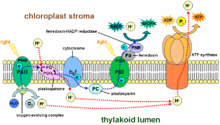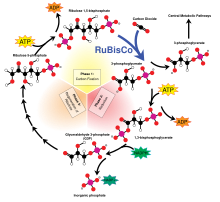Photosynthesis
| Completion status: this resource is considered to be ready for use. |
| Educational level: this is a primary education resource. |
| Educational level: this is a secondary education resource. |
| Subject classification: this is a biology resource. |
| Subject classification: this is a chemistry resource. |
Photosynthesis (from photo- [light] and synthesis [composition]) is the process by which plants and certain other organisms obtain and convert solar (or light) energy into chemical energy.
Introduction
[edit | edit source]

All cells need energy, the ability to perform or complete work, in order for them to maintain their existence. Even us humans need energy! If we do not have energy, we cannot do even the most basic things in life! These basic things include walking, standing, sitting, and even your heart beating! All cells require energy for (but not limited to) these five reasons:
- Use energy to carry out active transport.
- Synthesis of proteins and nucleic acids.
- Response to chemical signals at the cell surface.
- Movement (motor proteins) of organelles around the cell.
- Used to produce light in some organisms, such as fireflies.
Life as we know it depends on chemical energy, energy saved in chemical bonds. But how do certain organisms get this chemical energy? There are two ways in which an organism obtains energy:
- Autotrophs are organisms that do not eat or absorb other organisms for energy as they make their own energy. Most autotrophs, known as photoautotrophs, carry out photosynthesis (plants, protists, and bacteria). Autotrophs don't only just produce energy to satisfy themselves, but they also produce enough energy to satisfy other animals too: Autotrophs (plants, after sunlight) start the food chain (EX: Grass provides energy for a rabbit, who provides energy to several animals, such as snakes and foxes). If it wasn't for these producers (An autotrophic organism that starts the food chain cycle), we wouldn't have anything to eat!
- Heterotrophs are organisms that are not able to make their own energy, so they resort to absorbing or eating energy from other organisms. Heterotrophs are also known as consumers because they consume other organisms for energy in the food chain cycle. Examples of heterotrophs are foxes, cats, snakes, hawks, eagles, crocodiles, tigers, lions, and even us: humans!
Photosynthesis
[edit | edit source]Photosynthesis converts light/solar energy into chemical energy, and thus is very important to life. But, how does it work? Let's first take a look at the chemical equation for photosynthesis (reactants on the left, products on the right):
energy from the Sun + 6CO2 + 6H2O → C6H12O6 + 6O2
Here, we need 3 important elements in order to kick-start the process. We need sunlight, carbon dioxide and water. How do plants obtain all of these three elements?
Obtainment
[edit | edit source]

- Sunlight
Wavelengths of light are absorbed and reflected by molecules called pigments. In plants, the green pigment that absorbs sunlight is known as chlorophyll. Chlorophyll is found in the chloroplast, an organelle that is the site of photosynthesis (in plants).
Chlorophyll absorbs solar energy and transfers it to chemicals involved in the photosynthetic process. Sunlight contains all the colors of the rainbow (Roy G. Biv). All the colors hit the chlorophyll molecules, but only certain colors are absorbed. Chlorophyll absorbs well in the blue-violet and red sections of the visible light spectrum, whereas chlorophyll reflects most of the green light in the visible light spectrum, giving most plants a green color.
- Carbon Dioxide
Pipe-like structures in the leaves, known as stomata, control the flow of carbon dioxide into a plant and the flow of oxygen outside of the plant. The flow of these gases are also regulated by gaurd cells, cells that open and close the stomata.
- Water
In a vascular plant, pipe-like tissues conduct water to different parts of the plant. In a non-vascular plant, water is unable to be conducted, and therefore, must be absorbed from the plant's surroundings (such as in the soil).

The 2-step process
[edit | edit source]Now that we have the necessary "ingredients" to perform photosynthesis, we can get started! Photosynthesis occurs in two steps, the Light Reactions (also: light-dependent reaction) and the Calvin Cycle (also: dark-reactions, light-independent reactions, carbon fixation).
Light Reactions
[edit | edit source]
The light reactions occur in the thylakoid membrane of the chloroplast. It is made up of two photosystems:
Photons from the sun travel 93 million miles into Photosystem II of the thylakoid. This excites the electrons in the chlorophyll molecule, which are then shifted around various "electron-acceptors"--each electron-accepter causing the electron's energy state to diminish. Moving around these excited electrons cause the electrons, and hydrogen molecules, in H2O (water) to be "donated" over to replace the excited electron's place in the various electron-acceptors in the chloroplast. This causes oxygen to be created as a waste product, as water is essentially stripped off of its hydrogens and electrons, leaving the oxygen molecules all by themselves. As the electron's energy state diminishes, groups of hydrogen protons are transported from the stroma over to the lumen.
Then, Photosystem I allows NADP+, the final electron acceptor in the thylakoid, to accept the not-so-excited electron and a hydrogen proton to make NADPH. This is where the NADPH comes from. Meanwhile, in the lumen, the hydrogen protons, after getting pumped into the lumen, demonstrate chemiosmosis--they are then pumped back up into the stroma, causing ATP synthase. The ATP synthase then merges ADP with several phosphate groups, forming ATP (Adenosine Triphosphate - energy storage molecule). The ATP and NADPH formed by these reactions are needed in the Calvin Cycle.
The chemical equation for Light Reaction is as shown:
SL (sunlight) + H2O → O2 + NADPH + ATP
Calvin Cycle
[edit | edit source]
The two byproducts from our light reactions, ATP and NADPH, are transferred to the stroma, the liquid-filling area of the chloroplast not taken up by the thylakoids, to go through the Calvin Cycle. Six molecules of CO2 react with six molecules of 5-carbon molecule RuBP (also: Ribulose Biphosphate, ribulose-1, 5-biphosphate) to form 6 molecules of 3-carbon molecule phosphoglyceraldehyde (PGA). Electrons in the PGA and carbon dioxide are not in a high enough energy state to start this reaction by themselves, so an energy-source is needed: 12 ATPs and 12 NADPHs.
With all of these combined, 12 ADPs, 12 NADP+s, and 12 phosphate groups are created. The electrons in NADPH are at a higher energy state. When NADPH's electron's energy states go to lower energy states, it helps produce ADP and NADP+ to be formed by putting energy into the reaction. ATPs' electrons, when their phosphate groups are lost, are in a very high energy state. Like NADPH, when they enter into lower energy states, ATP helps drive the reaction.
As cycles reuse things, the Calvin Cycle reuses most of the PGAL to recreate RuBP. This "reusing" part of the cycle, just like in the beginning, will need energy: ATP, ADP and phosphate groups (no NADPH). Extra PGAL not used will be used to make glucose, or C6H12O6 (or any type of carbohydrate, starch or sugar).
The chemical equation of the Calvin Cycle is shown as follows:
CO2 + NADPH + ATP → C6H12O6
Overview
[edit | edit source]

Sources/See also
[edit | edit source]| Search for Photosynthesis on Wikipedia. |
| Wikibooks has more on the topic of Photosynthesis. |
| Look up Photosynthesis in Wiktionary, the free dictionary. |
- Talk:Photosynthesis#Extra_definitions
- How Cells Obtain Energy - Molecular Biology of the Cell. 4th edition.
- Biologymad.com - Chap. 5, Photosynthesis
- Youtube: Photosynthesis - KhanAcademy
- Youtube: Light Reactions - KhanAcademy
- Youtube: Calvin Cycle - KhanAcademy
- Youtube: How does Photosynthesis Happen - BYJU'S
